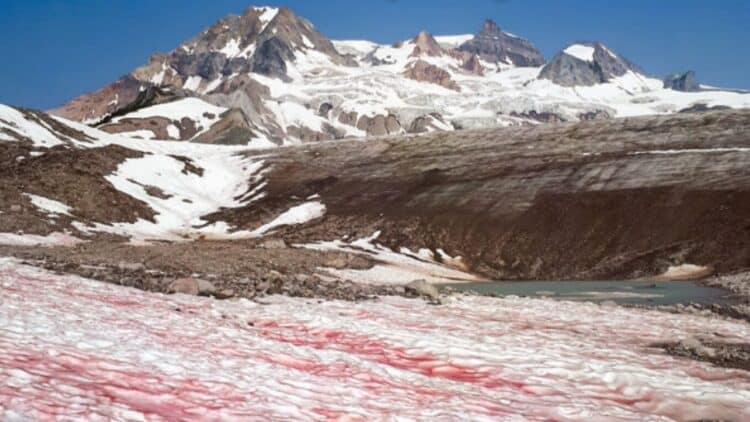Snow that changes from red to pink and orange… we’re talking about pink snow (also known as watermelon snow). Although this phenomenon is not new, it has recently been observed again in the western states of the USA, such as California, Utah, and Nevada. After a long period of drought that reduced the amount of snow in these regions, worsened by climate change. The reappearance of this natural event brings up concerning issues for the future of climate and water in these areas.
What is Pink Snow, and why does it occur?
Despite the name “pink snow”, it is actually green algae that cause the red, pink, and orange snow. This is the result of the proliferation of green algae that thrive in cold, snowy environments. The algae responsible for this colorful snow are called Chlamydomonas nivalis. This occurs as a way for the algae to protect itself from ultraviolet rays.
In other words, the algae produce a pigment that darkens their cells, and this pigment acts as a shield against ultraviolet rays, thereby protecting their DNA and other cellular components, as the algae are in a very bright environment.
To make it easier to understand, Scott Hotaling, a professor at Utah State University, draws a parallel between this phenomenon and what happens to the human body when we sunbathe:
“When you have very fair skin, it is proven that a person will have a lot more problems with the sun than people who have more pigmented skin, and the same goes for algae.”
That’s why it’s important to protect oneself from the sun, whether human or algae.
Why can Pink Snow be a problem?
In addition to producing the reddish pigment, the Chlamydomonas nivalis algae also absorb heat, causing the surrounding snow to melt faster.
Some research points out that the process that causes Watermelon Snow also reduces the albedo of snow, its ability to reflect sunlight. This means that its capacity to reflect sunlight decreases, and as a result, the melting, not only of snow but also glaciers, for example, is accelerated.
The major issue is that this process creates a vicious cycle because, as temperatures rise, the algae bloom more, intensifying local warming even further (contributing to broader changes in seasonal patterns around the world, as we already see impacting all four seasons).
The importance of monitoring Pink Snow for the future of the climate and water
Although there are no direct health risks associated with contact with Watermelon Snow, monitoring this phenomenon is crucial for predicting its long-term environmental impacts.
Scientists have been closely tracking these algae because their presence can serve as an indicator of climate change in mountainous areas, a growing concern given the staggering economic impacts of global warming, projected to reach $7 trillion.
If this phenomenon begins to happen more frequently, it will show that global temperature changes are advancing faster than expected, highlighting the failure in efforts to mitigate the climate crisis. Ultimately, understanding when these algae appear will help society anticipate problems such as prolonged droughts and impacts on agriculture.
Even though Watermelon Snow (or Pink Snow if you prefer) catches attention due to its appearance and its announcement of the end of winter, which many people find appealing, its impact goes far beyond aesthetics. It serves as a warning of the climate transformations that the planet is undergoing.
This phenomenon highlights the urgent need for global awareness and collective action. As these environmental shifts intensify, we must recognize the broader implications, not only for ecosystems but also for human societies dependent on stable weather patterns and water resources, which are increasingly threatened by climate change.


